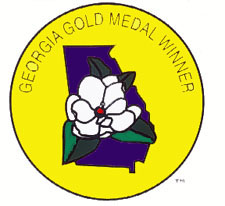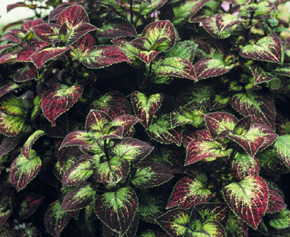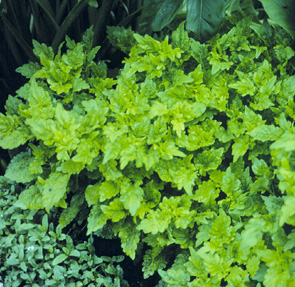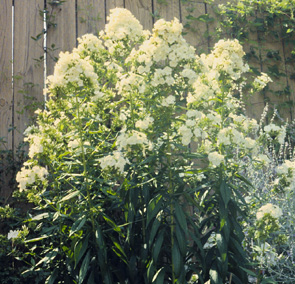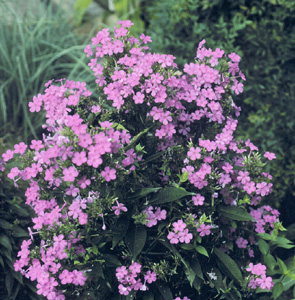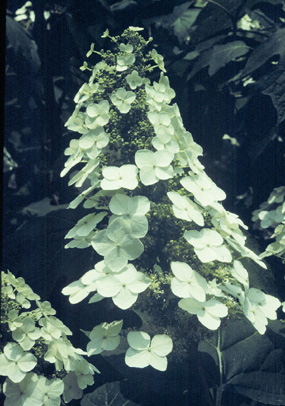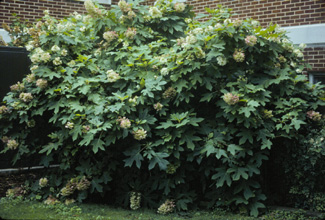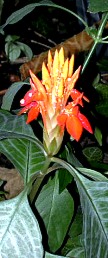 |
|
|||||||||||||||||||||
|
Sun-loving Coleus (Coleus x hybridus) Most gardeners are accustomed to growing coleus in the shadows of the garden. But plant explorers at the USDA have recently discovered a whole new breed of coleus in tropical Asia that not only tolerates the sun, but thrives in it. Today sun-loving coleus are revolutionizing the bedding plant and landscape industries. Their leaf colors are dazzling, ranging from deep crimson to brilliant chartreuse and golden sunset orange. Some plants have three or more colors on a single leaf. The leaves of Solar Sunrise, for instance, one of the most popular plants in the series, are deep brick red with chartreuse veins blending to a halo of yellow and white toward the leaf margins. Other popular selections in the sun-loving series are Solar Flare, Red Ruffles, Alabama Sunset, Cranberry Salad and Purple Ducksfoot.
Until recently, summer garden phlox (Phlox paniculata) has gotten mixed reviews from southern gardeners. Some say they flower poorly during hot summers, while others say they simply thin out and die over time. The main culprit for the plant's poor performance has been powdery mildew, a foliar disease that spreads rapidly during hot, humid weather and is difficult to control. Frustrated phlox growers will delight at the heat and mildew tolerance of David and Robert Poore Phlox. Although they are not totally mildew resistant, they have proven to be less susceptible to the disease than other garden phlox commonly grown in the South. Robert Poore Phlox bears vibrant purple flowers from May to June. It was introduced by Kim Hawkes of Niche Gardens in Chapel Hill, North Carolina. David Phlox has white flowers. It too blooms over a long period. Dr. Allan Armitage, Professor at the University of Georgia, says it's "the best of all the white cultivars." Robert Poore and David
Phlox look great when grown together in the garden, and they combine
well with other herbaceous perennials or annuals. Like other garden
phlox, plants grow as clumps that can be divided in fall for new
plantings or for sharing with friends.
Oakleaf hydrangea is no stranger in the southern landscape, but Alice Oakleaf Hydrangea is a superior selection taking the landscape and nursery trade by storm. While flower spikes on the native species range from 4 to 10 inches long, flowers on Alice Oakleaf Hydrangea average 10 to 14 inches in length. The parent plant is growing on the University of Georgia campus. Alice Oakleaf Hydrangea has an exceptionally long bloom period. Flowers emerge in June and remain in bloom four to six weeks, gradually fading to rosy pink, then tan by the end of summer. They make excellent cut flowers for summer floral arrangements. A rich burgundy fall color and cinnamon-colored exfoliating bark are other outstanding features of Alice Oakleaf Hydrangea. Alice Oakleaf Hydrangea grows quite large, 12 feet high and 12 feet wide. Use it as a single specimen plant in a shady shrub border or in groups of 3 to 5 plants in the background behind smaller plants. It looks particularly nice in a natural, wooded setting.
Southern magnolia has long been the aristocrat of southern landscapes. It's hard to imagine an Antebellum home without a couple of magnolias framing its entrance. But as property sizes shrink, many landscapes can no longer accommodate a tree that grows 50 feet wide and 80 feet tall. Little Gem Magnolia provides the same grace and charm as its native parent, but on a much smaller scale. Mature height is 15 to 20 feet with about a 10 feet width. Because of its small stature and evergreen foliage, Little Gem Magnolia can be used in a variety of ways in the landscape. Use it as a small specimen tree on the corner of the home, as a background plant to lend a dark-green backdrop to shrubs, or as a hedge along the property line. With careful pruning it can also be trained as an espalier along a solid wall. As you might expect, leaves
and flowers on Little Gem Magnolia are also smaller than the native
species, which are an added benefit since leaf litter is much less
of a problem. Leaves are four to six inches long, dark glossy green
above and fuzzy brown below. Flowering begins in summer and continues
through fall. Flowering also begins at an early age. A three-gallon
size plant is likely to flower the first growing season. Flowers
are delightfully fragrant.
For an account of the goals of the program and a complete listing of Georgia Gold Medal plants from its inception, please visit Georgia Gold. This page reproduced with permission of the University of Georgia Cooperative Extension Service.
|
||||||||||||||||||||||
